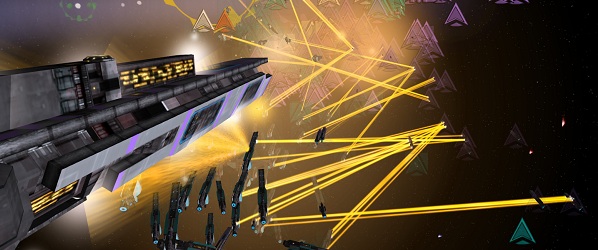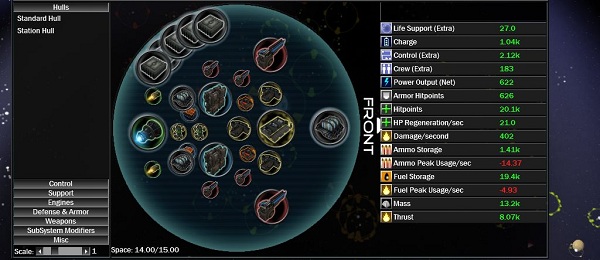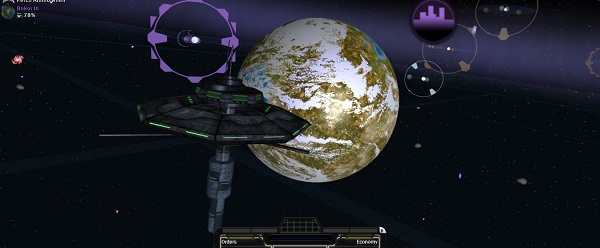Wot I Think: Star Ruler
Heavens Above
Before I get into the nitty-gritty, yes, we do know when long-zoom 4X indie spectacle Star Ruler was originally available to buy. However, anyone who has followed the game can tell you that what you get for your money now is a different beast to what you got at that nascent time. What could be regarded as the actual launch is now here. We are all familiar with the terror of unfinished games and the horror of 0-day patches. It is easy to believe the entire global computing infrastructure has been put in place so that developers could ship as soon as they got tired and wanted a holiday. Star Ruler did turn up in that sort of unsatisfactory state, but the developers admitted that and they put out a representative demo as well. Since then, their support of the product has been exemplary. While I may not agree with everything they’ve done, the fact that they continue to listen and improve the game is exactly what we so often demand and so rarely receive. But the play’s the thing, so here’s wot I think.
At first glance, Star Ruler is mind bogglingly complex. The UI has come in for a lot of criticism but I found that in its current state it usually helped me find what I needed. On top of that, the tutorial is clear and informative. The problem with the early hours is not just the sheer amount of stuff that it’s possible to do at any one time, it’s the fact that the consequences of any given action aren’t always entirely clear. The complexity still astonishes me but, crucially, after a few play sessions the confusion is hardly an issue at all. That’s not because I suddenly understood everything, it’s because I stopped caring. Early on I realised that I could prompt and prod my researchers to learn about specific things but I didn’t actually know if they were listening to me very much. Technology kept advancing at a steady rate though so I simply nodded and tried to look like I was in charge.
I’ve learned to focus on one thing until I get distracted by something more interesting. If I want to concentrate on colonising as many planets as possible, I build scouts. The scouts fly off to discover new systems. I build colony ships. The colony ships fly off and colonise the planets. Done. While all that's happening, I could be designing bloody great ships o’ war and defensive space stations. I could be tweaking my economy or converting a planet into a moveable, all-conquering super-colony. With options like that last one, I’m not really thinking about my economy, I’ll be honest.
There are two reasons that all these things are possible. The first is the scale at which Blind Mind have allowed players to realise their galactic ambitions. You can churn out ships by the bucket-load. And I mean some kind of gigantic space bucket. Not only can fleets be massive in number, each ship can be massive in size. When choosing what type of craft you want, the first thing is to add components to a blueprint. Some are necessary, most are optional. Things like guns, shields and more guns. They are dragged and dropped onto a circular grid, an abstract representation of the ship, while the blueprint calculates energy production/consumption, range and other handy stats.
It’s a great tool that allows a huge amount of options without feeling like it will totally break balance. And if the balance was overturned, it'd be because you'd constructed some kind of sentient and terrible cathedral-ship that melted entire planets just by thinking about them, at which point balance would be the last thing on your mind. Once the systems and subsystems are in place you can alter their scale and the scale of the ship itself. Normally a fighter (think TIE) would be a lot smaller than a capital ship. In Star Ruler you can make that fighter gargantuan, sticking more powerful weapons, shields and engines on to compensate for its sheer size. This is a game in which ships can kill the stars that men seek to rule.
Upping the scale is conceptual, it’s part of the vision of what a 4X game should be achieving. Blind Mind’s other masterstroke is intelligent automation. This aspect isn’t as all-enveloping as in Distant Worlds but it means menial tasks don’t have to be repeated over and over. Given a galaxy with so many systems to inhabit (the upper limit is effectively set by the heft of your computer), it wouldn’t be right to spend time overseeing the construction of a rubber tubing factory on Garbalon III. I’m the Star Ruler, serfs, let me rule some stars. Everything else should be someone else’s job. Say a planetary governor. These handy little chaps can be given a brief (balanced, metal production etc.) and will fill a planet with useful structures before you even realise it’s been colonised. These structures then automatically begin churning out resources to be thrown into the furnaces of industry. The furnaces of industry then build ludicrously gargantuan ships with which to crush the enemies of the Star Ruler. When resources are low, construction work slows right down, which is preferable to a host of annoying popup warnings. And I should add that despite being almost completely negligent of planetary micromanagement most of the time, I never found my economy or industry had simply broken itself, which is a relief. Too often, complexity seems to provide more easily accessible fail conditions, but I didn’t find that to be the case here.
At this point, colony ships have expanded the empire, and my many planet are thriving hubs of industry and capitalism. I’ve built all these ships. I should probably perform an act of interstellar aggression. Luckily for me, there are up to ten enemy empires in the game. Like most things, the exact number is up to the player during setup. Referring to them as ‘enemy empires’ is very deliberate. Usually, I’m happy to build, expand, form alliances and conduct research in games of this sort but the first mild criticism I’ll level at Star Ruler is that everything does seem geared toward aggressive conquest. In my experience these aliens are usually keen to engage in the delicate ballet of fleet-to-fleet, zero gravity combat, but that’s not the only thing that encourages war. It’s simply that constructing ships then hurling those ships into conflict is the most entertaining part of the game. A Star Ruler becomes jaded with the simple acts of colonisation and expansion. Pretty soon all those billions of people begin to look like pieces on a board.
The AI itself seems very effective and it will throw some interesting things your way. But the dealings with other empires highlight my biggest reservation about the game. There’s not a huge amount of character to my empire or any of the others and, eventually, this means the hugely impressive number crunching starts to look like just that. I don’t care about individual planets or systems, let alone the people who supposedly live on them. They’re statistics and when the numbers go up, I’m happy, when they go down I try to correct it. Not because this is mine and I am proud of it but rather because I want a series of processes to function correctly.
This lack of attachment won’t bother some people at all, in fact I’m sure some people don’t want to know anything about their governors and pilots except that they can govern and pilot. But it bothers me a little that those governors aren’t pretending to be little chaps at all; they are drop down menus that happen to be called ‘governors’. None of this means I want another game entirely, it just means I would enjoy more feedback and non-numerical detail.
If you think that concentrating on the hard facts is a good thing, this is probably the game for you. There is still a demo available, which isn't updated quite as often as the full game but is still a fairly good representation. If you do purchase, what you're getting is a heavily customisable 4X game which refuses to accept that upper limits should exist. The first hint of that comes when you form a galaxy for your new game. They come in various shapes (spiral, cluster, spherical and more!) and you can choose the number of systems at the outset. I tried 10,000 just to see what would happen. That's 10,000 stars. I could have gone higher. Scrolling through the galaxy in 3D was quite amazing, knowing that theoretically I could own it all one day. That, for me, is when the game is at its brilliant best, taking the long view and being above all petty concerns. At those points, being a, nay the, Star Ruler is awesome. But after a while I want to go down to the surface and see what it’s all about, up close and personal. Maybe I’m just not cut out for the job. I’d make a mean rubber tubing factory foreman though.
Star Ruler is out now.




